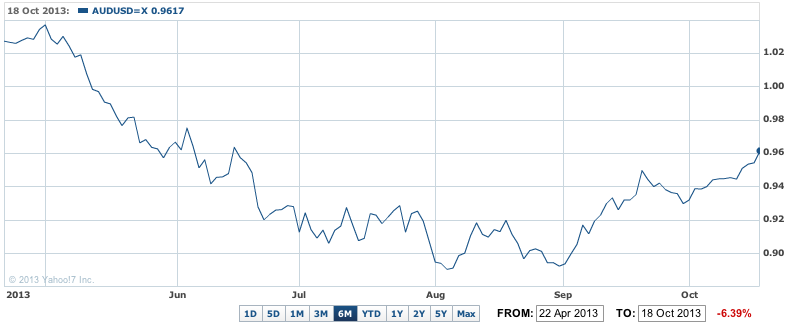Washington has cooled, but there are still a number of issues/situations/factors to be aware of as the markets continue on their current bullish trajectories.
First up, gold, oil and other commodities (perhaps with the exception of iron ore) are going to be whacked from time to time, despite signs of stronger growth in China, Europe and a number of other economies.
For Australia the value of the dollar is the big factor that is going to pressure companies, investors, Government budgets and prices the longer it remains around its current levels.
In fact the longer the dollar remains at these levels, the less impact the September 7 election result will seem to have had for markets and business generally.
A rising dollar (and perhaps weak rising unemployment) will have the capacity to squeeze the life out of parts of the domestic economy.
The currency touched 97 US cents in trading Saturday morning our time – and ended up 2.1 US cents for the week around 96.77c.
The longer the US Federal Reserve doesn’t start cutting its $US85 billion a month of spending, the greater the chance the dollar will return to parity with the greenback at $US1.000.
6 Month AUDUSD – Here we go again: Aussie dollar surges towards parity?

RBA governor Glenn Stevens said in Sydney on Friday that a "lower currency than this would be helpful in rebalancing the growth sources of the economy".
"I’d prefer it to be lower than this rather than higher," he said in answer to a question.
"I don’t think you could really credibly say that the levels of costs and productivity in Australia, I don’t think those things would point you to…present levels as being sustainable," Mr Stevens said on Friday.
That’s certainly the case, but that had been the case for much of 2011-13 and the market ignored that until the US Fed started talking about cutting its spending back in May.
The dollar has started falling earlier in the year and that accelerated in April – May and the currency reached a low of 88.48 US cents. It is now 10% above that low.
But no one knows what will end the current surge – a Fed decision to start tapering might help, but the market seems to be accepting that such a move won’t have a big impact in coming moths.
So the RBA and Mr Stevens look powerless at the moment about having any sort of meaningful impact.
A rate cut might help, but that in turns risks igniting the developing boom in house prices, especially in Sydney and Melbourne.
Like for much of 2011, 2012 and the first half of 2013, our AAA (stable) credit rating and solid economy is going to attract more money, even if other economies continue their hesitant recoveries.
The big problem is the blow to confidence in the US from the budget and debt ceiling silliness – that will make stable, high rated Australia look better, even as the Fed starts cutting its spending in 2014.
Good news from China will help keep the dollar higher – the 7.8% growth rate for the September quarter was expected, and good news.
This week the early report on October for the country’s manufacturing sector will be released. It will provide a short term impact and that’s all.
Even though production, urban investment and retail sales were a touch weaker in September, they were strong enough to keep investors confident about the rest of the year.
China’s crude steel output jumped 11% to 65.42 million tonnes in September from September 2012, but was down 1.3% from the 66.28 million tonnes of August. But it was still at near record levels.
No wonder iron ore imports were a record 74.8 million tonnes in September.
Steel production on a daily base was close to all time highs and it looks like continuing. Iron ore prices remained above $US130 a tonne, despite a lot of new iron ore capacity starting to produce ore in the quarter in Australia and Brazil.
We saw last week with the production reports from Rio Tinto and Fortescue that iron ore is doing well (and holding up our trade account, for that matter). BHP Billiton’s production report for the three months to September will provide further confirmation when released tomorrow.
This will all make for little change of the intense pressures on the trade account, Federal and state budgets, offshore retailing purchases by Australian consumers (and the complaints by some local retailers), overseas travel and weak inbound tourism.
A stronger dollar could also feed through into the surging local property markets by dragging in more offshore interest, especially from China and other Asian markets.













